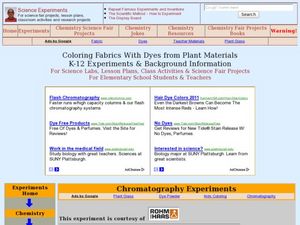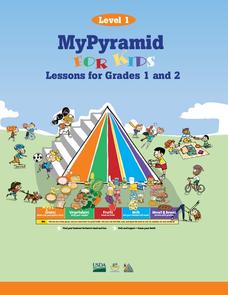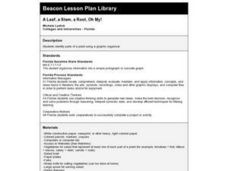Curated OER
Coloring the Life Cycle of Fruits and Vegetables
Students investigate how fruits and vegetables change and grow. In this life cycle of fruits and vegetables lesson, students observe the changes in fruits and vegetables as they grow and record the colors on a worksheet.
Curated OER
Rename Fruits, Vegetables and Spices
Students explore fruits and vegetables. In this fruits and vegetables lesson, students study traits of various fruits, vegetables and seeds. Students rename fruits, vegetables and seeds.
Curated OER
How are Seeds the Same and Different?
Students examine seeds from various plants. For this science lesson, students cut open fruits and vegetables in order to see the seeds. Students describe each type of seed and classify the seeds.
Curated OER
Eat Your Fruits and Vegetables
Students will discuss the benefits of eating healthy. In this healthy diet instructional activity, students will discuss the importance of eating fresh fruit and vegetables when pregnant or breastfeeding and how to identify healthy...
Curated OER
Coloring Fabrics With Dyes from Plant Materials K-12 Experiments & Background Information
Students investigate the effects of acid and bases on dyes made with plant materials. In this chromatography lesson students predict color outcomes and complete a lab activity on color combinations.
Curated OER
Fruits and Vegetables
Students explore the differences between plants with seeds and seedless. In this fruits and vegetables lesson students examine some vegetables and nuts that are really fruits.
Curated OER
All About Seeds!
How do fruits relate to flowers and seeds? Identify the seeds and their purpose with a coloring activity for kindergartners. Once they color the seeds of apples, bananas, and peas (among others), kids get hands-on experience with bean...
Curated OER
Where Do They Grow?
Students complete worksheets. In this fruits and vegetables lesson, students complete a worksheet on where fruits and vegetables grow where they draw connecting lines. Students color fruits and vegetables on a worksheet.
Curated OER
Food Color Chemistry
Students investigate plant pigments in fruits and vegetables. In this plant pigments lesson plan, students observe the effects of pH changes on chlorophyll in one demonstration and they observe the effects pH changes on flavonoids in...
Curated OER
Pesticide Watch Card
Students examine human health by identifying dangerous pesticides. In this agriculture instructional activity, students research the food production system in the United States and discuss dangers such as pesticides, chemicals and...
Alabama Wildlife Federation
Colors to Dye for!
Nature provides a rainbow of colors at one's fingertips. A hands-on activity uses natural plant materials to create all-natural dyes. Plants range from fruits and vegetables to flowers and greens. After extracting the pigments, eager...
Curated OER
Activity #7 Apple Color Change
Students compare the different rates of reaction between an apple covered with vitamin C and an apple with no vitamin C. They compare the different rates of reaction between an apple placed in the sun and one not exposed to the sun. ...
Curated OER
Eat Your Plants
Students explore fruits and vegetables. In this fruits and vegetables instructional activity, students work in small groups investigating plant parts. Students discover that fruits and vegetables originate from different parts of plants.
Curated OER
Pick a Better Snack and Act
Students make healthy choices. In this healthy living mini-unit, students make healthy lifestyle choices through hands-on activities, songs and movement. This mini-unit includes lessons on the food pyramid, fruits, vegetable, and staying...
Curated OER
Pigment Plucking
Students examine pigments found in different fruits and vegetables and practice the processes for extracting the pigments. Pigments are used to create artwork and a class PowerPoint presentation is made on the different types of plant...
Curated OER
Natural Dye Lesson Plan
Students investigate major pigments which occur naturally in fruits and vegetables, and to use them to dye a number of items. They study the effects of pH on anthocyanin on pigments.
Curated OER
Seed Sensation
Students explore seeds through dissecting, sorting, comparing and contrasting. They draw their observations of both a closed and open seed and then they label the parts of a seed. They brainstorm where seeds come from. They compare seeds...
Curated OER
Plant Parts
Little ones identify the parts of a plant and practice following directions at the same time. They color each part of the flowering plant the color indicated on the sheet. Roots are brown, leaves are green, the flower is red, and the...
Education Outside
Natural Dye Tie-Dye
Up-cycle, or reprocess waste materials, into colorful tie-dye clothing or banners with an activity that uses fruits and vegetable juices as dye sources.
Curated OER
My Pyramid for Kids
Students become familiar with the proper amounts of different types of foods they should eat each day. In this food pyramid lesson, students complete worksheets to develop better eating habits. Students understand the importance of...
Curated OER
A Leaf, a Stem, a Root, Oh My!
Students conduct Internet research on plants and complete a WebQuest on vegetable plants. They use a graphic organizer to display their findings, observe actual vegetables and design a salad, noting which part of each plant is included.
Curated OER
PLANT PARTS WE EAT
Students identify an assortment of vegetables and learn how to locate the parts humans use for food. Students identify the plant parts we eat. Students color the pictures on their worksheets as provided. Students match the plants to the...
Curated OER
The Human Body
Explore the human body through hands-on activities. Young learners will trace their bodies and place cut out body organs in the proper place, print patterns using cut fruit, sing songs about good nutrition, and use their five senses...
Curated OER
Animal Food Chains
An engaging, informative, and colorful presentation focuses on food chains. Learners view many great photographs of animals, and must do some critical thinking regarding an animal's place in a food chain, and whether an animal is...























